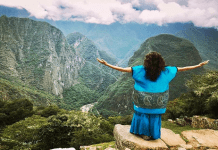Beyond the famous Half Dome in Yosemite National Park, about a 90-minute drive from Yosemite Valley, lies a peaceful area known as Tuolumne Meadows. Here, less-visited domes and peaks offer a serene experience in the subalpine terrain. Hidden just out of view is Sing Peak, standing 10,552 feet tall in the southeastern corner of the park.
According to Yosemite park ranger Yenyen Chan, Sing Peak is one of the 19 peaks listed on the park map, even though there are hundreds in Yosemite. The peak, named after Chinese American chef Tie Sing in 1899, has remained largely unrecognized for more than a century.
Chinese immigrants have played a significant role in Yosemite’s history. They helped build much of the park’s early infrastructure and managed the kitchen and laundry services at the Victorian-style Wawona Hotel, built in 1856. Despite their contributions, they have often been overlooked due to the nation’s long history of anti-Asian sentiment and discrimination. For example, the Chinese Exclusion Act of 1882 banned Chinese laborers from entering the country, a policy that lasted until 1943.
Yenyen Chan, who became a US Park Ranger in 2003, first learned about Yosemite’s Chinese American history in 1993 when her supervisor mentioned that Chinese laborers built the Tioga Road in 1882-83. Intrigued, Chan began researching on her own, scouring libraries across California for documents and photographs. She discovered that 250 Chinese American and 90 white laborers built a 56-mile stretch of the Great Sierra Wagon Road, which became today’s Tioga Road, in just 130 days.
Before that, Chinese immigrants built the Wawona Road around 1874 under harsh winter conditions, using basic tools. They completed the 23-mile road in 18 weeks. Today, visitors entering Yosemite through the south entrance on Highway 41 still travel on parts of this road.
The Wawona Hotel also employed Chinese immigrants, including head chef Ah You, who managed the kitchen from 1886 until 1910 and worked at the hotel for 47 years until 1933. Despite their hard work, these Chinese workers were often kept out of sight.
Mark Twain praised the diligence of California’s Chinese laborers in his 1872 travel book “Roughing It,” noting their industriousness and lack of laziness.
Encouraged by a mentor, Chan organized a seminar and all-day hike about Yosemite’s Chinese American history. One of her discoveries was the story of Tie Sing. Despite the challenges of finding reliable records, Chan learned that Sing was born in Nevada to Chinese immigrants and had documents with another Chinese name, a wife, and at least one child in Hong Kong.
Sing was known for his ability to prepare gourmet meals in rustic settings. In 1915, Assistant Secretary of the Interior Stephen Mather hired him for a two-week wilderness trip with influential politicians, newspaper editors, businessmen, and lawyers through the Sierras. This trip, known as the Mather Mountain Party, aimed to gain support for establishing the US National Park Service. Sing’s exquisite meals, served on white tablecloths with fine china, impressed the group and helped secure the creation of the National Park Service the following year.
Chan’s efforts to uncover and share Yosemite’s Chinese American stories connected her with Jack Shu, then California State Park Superintendent, and the Chinese Historical Society of Southern California (CHSSC). Together, they launched the Yosemite Sing Peak Pilgrimage in 2012. Each year, CHSSC members, avid hikers, and history enthusiasts retrace the park’s Chinese American pathways, visiting sites where Chinese laborers worked and walking down the roads they built.
The pilgrimage includes history talks, hikes along the original Tioga Road, and a climb to Sing Peak. Participants also enjoy potluck dinners and camp cooking demonstrations to honor Tie Sing’s legacy of preparing magnificent meals in the wilderness.
During one pilgrimage, the group visited a run-down building near the Wawona Hotel, which had once been a laundry building constructed in 1917. The group decided to restore the building and use it as an exhibition space to share the park’s Chinese American history. With funding from Sandra and Franklin Yee, the restored Chinese Laundry Building opened in October 2021. Visitors can now learn about the park’s Chinese American influences, thanks to Chan’s years of research.
Chan believes there is still much more to uncover about Chinese history in Yosemite and other national parks like Sequoia and Yellowstone. She hopes her work inspires a greater appreciation of human history.
In summary, the contributions of Chinese immigrants to Yosemite National Park are significant but have often been overlooked. Efforts by individuals like Yenyen Chan and organizations like the CHSSC are helping to bring these stories to light, honoring the legacy of these early pioneers and ensuring their place in history is recognized.























